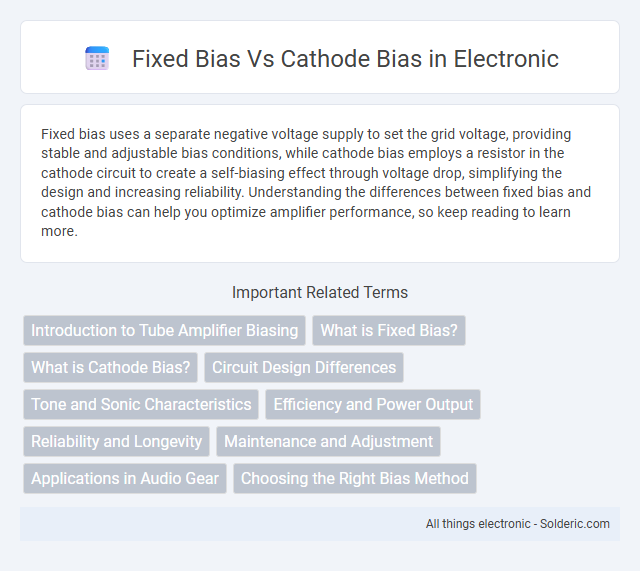Fixed bias uses a separate negative voltage supply to set the grid voltage, providing stable and adjustable bias conditions, while cathode bias employs a resistor in the cathode circuit to create a self-biasing effect through voltage drop, simplifying the design and increasing reliability. Understanding the differences between fixed bias and cathode bias can help you optimize amplifier performance, so keep reading to learn more.
Comparison Table
| Feature | Fixed Bias | Cathode Bias |
|---|---|---|
| Biasing Method | External voltage applied directly to grid | Self-bias via cathode resistor voltage drop |
| Stability | Less stable; requires adjustment for tube variations | More stable; self-regulates current changes |
| Component Complexity | Requires fixed bias supply (negative voltage source) | Simple; uses cathode resistor and bypass capacitor |
| Adjustment | Manual bias setting necessary | Automatic bias setting via resistor value |
| Power Efficiency | Higher efficiency due to precise biasing | Lower efficiency; voltage drop reduces gain |
| Application | High-fidelity amplifiers, guitar amps needing precision | General purpose, affordable, and reliable amps |
Introduction to Tube Amplifier Biasing
Tube amplifier biasing involves setting a stable operating point for vacuum tubes to ensure optimal amplification and longevity. Fixed bias applies a constant negative voltage to the control grid, allowing precise control of tube conduction, whereas cathode bias uses a resistor in the cathode circuit to generate a self-adjusting bias voltage through current flow. Proper biasing impacts tube performance, distortion characteristics, and heat dissipation, making the choice between fixed and cathode bias crucial for amplifier design.
What is Fixed Bias?
Fixed bias is a method of setting the operating point of a vacuum tube or transistor by applying a constant negative voltage directly to the control grid or base. This voltage remains stable and independent of the device's current, ensuring consistent amplification characteristics. Your circuit's performance can be precisely controlled with fixed bias, though it may require additional components like a negative power supply.
What is Cathode Bias?
Cathode bias is a self-biasing method in vacuum tube amplifiers where a resistor is placed between the cathode and ground, creating a voltage drop that sets the tube's operating point automatically. This type of bias improves stability by compensating for variations in tube characteristics and temperature changes, enhancing the amplifier's reliability. Your amplifier's performance can benefit from cathode bias due to its simple design and inherent negative feedback, which reduces distortion.
Circuit Design Differences
Fixed bias circuits use a separate resistor connected to the grid of a vacuum tube or transistor, providing a constant negative voltage regardless of current changes, which simplifies initial adjustment but offers less stability. Cathode bias employs a resistor in the cathode or emitter leg, creating a self-adjusting voltage drop proportional to current flow, enhancing thermal stability and reducing distortion in your amplifier design. Circuit designers choose between fixed and cathode bias based on trade-offs in complexity, stability, and performance requirements.
Tone and Sonic Characteristics
Fixed bias provides a tighter, more consistent tonal response with enhanced headroom and clarity, often resulting in a brighter and more articulate sound ideal for precise, dynamic playing. Cathode bias contributes a warmer, more compressed tone with smoother harmonic overtones and natural compression, producing a vintage, creamy sound favored in blues and classic rock styles. The choice between fixed and cathode bias directly influences amplifier feel, sustain, and harmonic complexity, shaping the overall sonic character.
Efficiency and Power Output
Fixed bias circuits provide more stable and higher power output by maintaining a constant grid voltage, enhancing amplifier efficiency under varying signal conditions. Cathode bias offers improved thermal stability but typically results in slightly lower power efficiency due to voltage drop across the cathode resistor. Your choice depends on whether maximum power output or circuit stability is the priority in your design.
Reliability and Longevity
Fixed bias offers greater reliability and longer component lifespan by maintaining a stable bias voltage independent of tube current variations, reducing thermal stress on the tube. Cathode bias provides self-regulation and protection against excessive current, but its reliance on cathode resistor voltage drop can introduce drift, potentially affecting long-term stability. Overall, fixed bias circuits tend to support enhanced longevity in high-performance applications, while cathode bias is favored for its inherent simplicity and fail-safe characteristics.
Maintenance and Adjustment
Fixed bias circuits require periodic voltage measurement and manual adjustment to maintain the correct grid voltage, which can be time-consuming and demands careful equipment calibration. Cathode bias offers a self-regulating mechanism through a cathode resistor, significantly reducing maintenance needs and providing stable operation without frequent adjustments. Your amplifier's reliability increases with cathode bias due to its inherent automatic bias stabilization, making it a preferred choice for ease of maintenance.
Applications in Audio Gear
Fixed bias in audio gear provides consistent and precise control over tube operating points, enhancing performance in high-fidelity amplifiers where stability and minimal signal distortion are critical. Cathode bias offers self-regulating current flow, making it ideal for guitar amplifiers and vintage-styled audio equipment due to its simplicity and natural compression characteristics. The choice between fixed bias and cathode bias impacts tonal quality, amplifier headroom, and maintenance requirements in professional audio applications.
Choosing the Right Bias Method
Choosing the right bias method for your amplifier depends on factors like stability, ease of adjustment, and operating point accuracy. Fixed bias offers precise control and higher efficiency but requires careful adjustment and monitoring to avoid thermal runaway. Cathode bias provides self-regulation and improved reliability, making it ideal for beginners or applications needing simpler maintenance.
Fixed bias vs Cathode bias Infographic

 solderic.com
solderic.com